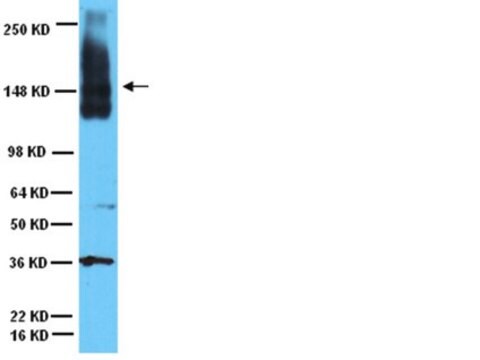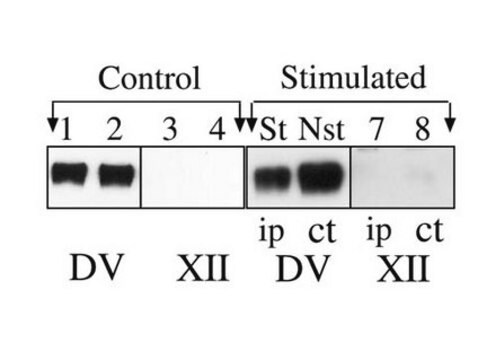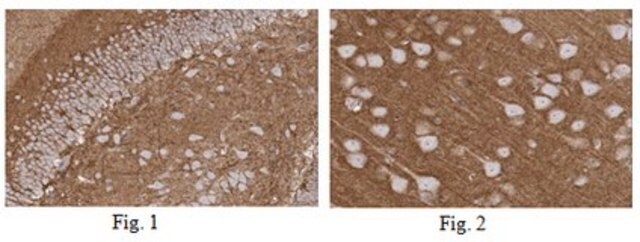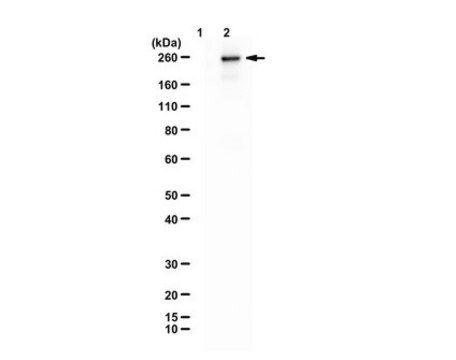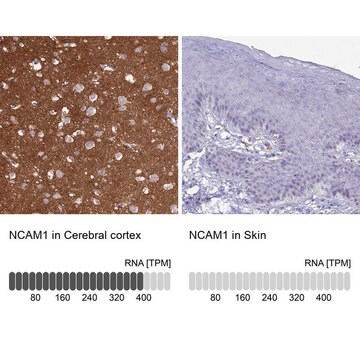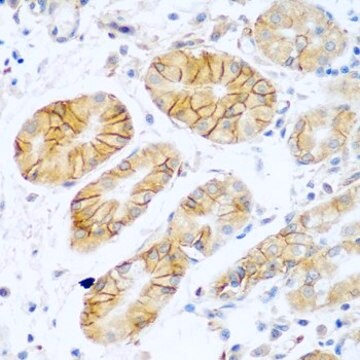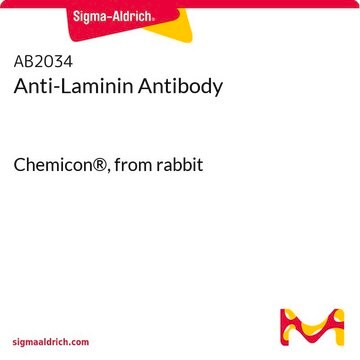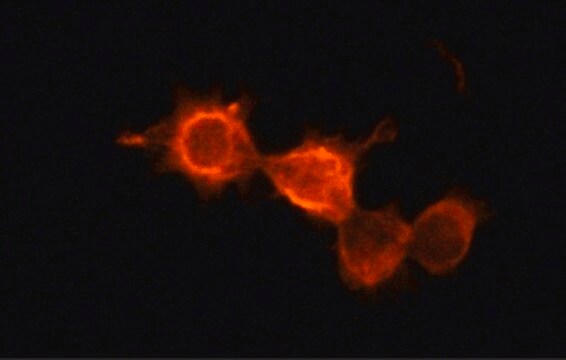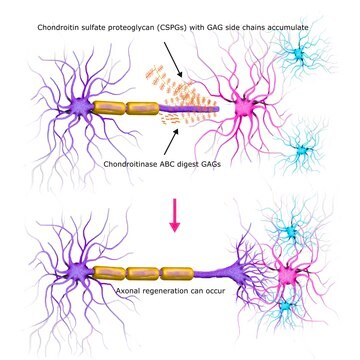推薦產品
生物源
mouse
品質等級
共軛
unconjugated
抗體表格
ascites fluid
抗體產品種類
primary antibodies
無性繁殖
NCAM-0B11, monoclonal
分子量
antigen 140-180 kDa
包含
15 mM sodium azide
物種活性
rat, human
技術
immunocytochemistry: suitable using cells and tissues
western blot: 1:100 using a freshly prepared extract from newborn and adult rat brain, or rat cerebral cortex extract
同型
IgG1
運輸包裝
dry ice
儲存溫度
−20°C
目標翻譯後修改
unmodified
基因資訊
human ... NCAM1(4684) , NCAM2(4685)
rat ... Ncam1(24586) , Ncam2(288280)
一般說明
Monoclonal Anti-N-CAM (mouse IgG1 isotype) is derived from the hybridoma produced by the fusion of mouse myeloma cells and splenocytes from an immunized mouse. Neural cell adhesion molecule (N-CAM), the best characterized CAM, exists in adult brain. It belongs to the family of sialoglycoproteins, which arise from alternative splicing of mRNA transcribed from a single gene. Immunocytochemical data indicate that in the adult, N-CAM is expressed mainly in cells of the nervous system. There are indications that N-CAM may also be expressed by non-neural cells in the adult, as it has been found in studies of various embryonic developmental stages.
Mouse monoclonal clone NCAM-0B11 anti-Neural Cell Adhesion Molecule antibody localizes the high molecular weight isoform of N-CAM (neural cell adhesion molecule) in human and several other mammalian species. The antibody shows a strong reaction to N-CAM A/N-CAM 180, however it also recognizes N-CAM B/N-CAM 140. In an immunoblot, the product reacts with polysialated N-CAM in embryonic material. Breakdown products of N-CAM may be stained; they appear as bands lower than 100 kD on the immunoblot.
免疫原
growth cone enriched plasma membrane fraction from E17 rat forebrain.
應用
Applications in which this antibody has been used successfully, and the associated peer-reviewed papers, are given below.
Immunofluorescence (1 paper)
Immunohistochemistry (3 papers)
Immunofluorescence (1 paper)
Immunohistochemistry (3 papers)
Monoclonal Anti-Neural Cell Adhesion Molecule antibody produced in mouse has been used in:
- Immunofluorescence
- Immunohistochemistry
- Immunoblotting
生化/生理作用
Neural cell adhesion molecule (N-CAM) are believed to be involved in cell-cell interactions and probably play an important role in embryogenesis and development.
免責聲明
Unless otherwise stated in our catalog or other company documentation accompanying the product(s), our products are intended for research use only and are not to be used for any other purpose, which includes but is not limited to, unauthorized commercial uses, in vitro diagnostic uses, ex vivo or in vivo therapeutic uses or any type of consumption or application to humans or animals.
未找到適合的產品?
試用我們的產品選擇工具.
儲存類別代碼
10 - Combustible liquids
水污染物質分類(WGK)
nwg
閃點(°F)
Not applicable
閃點(°C)
Not applicable
客戶也查看了
Neural cell adhesion molecule (NCAM) isoform expression is associated with neuroblastoma differentiation status
Winter C, et al.
Pediatric Blood & Cancer, 51(1), 10-16 (2008)
Neural cell adhesion molecule expression on renal interstitial cells
Markovic-Lipkovski J, et al.
Nephrology, Dialysis, and Transplantation, 22(6), 1558-1566 (2007)
Fritz W Lischka et al.
The Journal of comparative neurology, 511(3), 360-372 (2008-09-23)
The mucopolysaccharidoses (MPS) are a family of lysosomal storage diseases resulting in developmental defects and, in some types, mental retardation and other neurological symptoms. To gain insight into the neurological dysfunction in MPS, we examined the morphology of olfactory epithelia
J M Neill et al.
Experimental eye research, 51(5), 573-583 (1990-11-01)
Invagination of the optic vesicle to form the optic cup results in the formation of two apposed layers of neuroepithelium which follow divergent developmental pathways. Changes in the expression of cell surface molecules may be either the cause or result
Hong Wang et al.
The Journal of neuroscience : the official journal of the Society for Neuroscience, 27(40), 10703-10713 (2007-10-05)
Patients with viral and bacterial infections or other inflammatory illnesses often experience taste dysfunctions. The agents responsible for these taste disorders are thought to be related to infection-induced inflammation, but the mechanisms are not known. As a first step in
我們的科學家團隊在所有研究領域都有豐富的經驗,包括生命科學、材料科學、化學合成、色譜、分析等.
聯絡技術服務